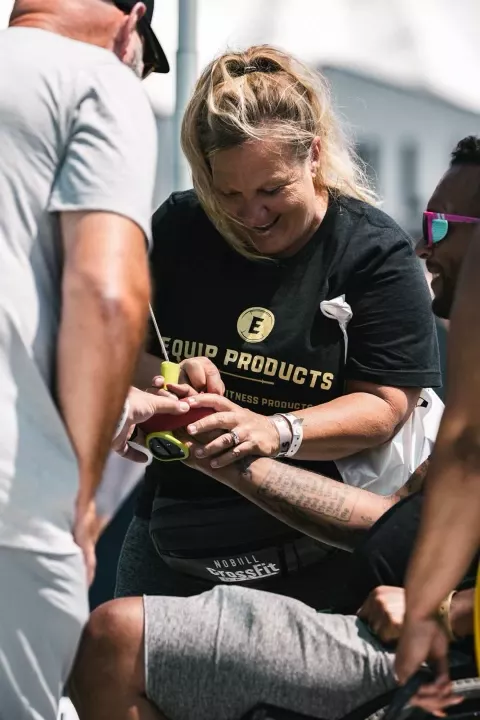The 13th stop on the “B.Friendly Fitness” offseason tour is stop number two at a competition which will inherit a role in the CrossFit Games season for 2024. Kevin and Shannon Ogar will take over for the adaptive community in a big way next season as they continue to usher in the pursuit of increasing the legitimacy of a true championship caliber CrossFit Games event next season.
One of my personal objectives this offseason was to get to three specific competitions:
- A teenage only competition (Pit Teen Throwdown)
- A masters only competition (Masters Fitness Collective… I would have done two including the Legends Championship, but it coincided with a previous commitment in Dubai)
- And an adaptive only competition (WheelWOD Games)
I’m both happy and grateful to have met those objectives, and appreciate all the competition organizers for welcoming me into their ecosystems.
Friday Afternoon
The WheelWOD Games spanned four days running Thursday through Sunday; I was only able to make it out for Friday and Saturday, but the amount I learned in about 30 hours was significant.
The first event I got to watch live, Waterfall Burnout (A,B,C,D) was actually a four part event featuring four separate 4:00 AMRAPs, with 2:00 transitions between each station.
In total there were 11 heats (several of which included two or three divisions) which cycled through the event. A new heat would start every 10:00, meaning once two heats were on the floor, two heats would always be on the floor (either at stations 1 and 3, or 2 and 4).
The entire concept of this event was brilliant in my opinion:
- Many things could be tested in a short amount of time.
- Fans could watch all the divisions in a fast, fun, and calculated manor.
- Athletes were tested on a variety of implements, while also clearly testing one of the biggest x-factors in the sport of fitness (the ability to recover and repeat an intense effort)
- And for people like me, it was extremely insightful to see how the competition directors scaled different workouts for each division depending on varying limitations and needs for the athletes.

Station A- 4:00 Amrap, Rowing for Max Meters
The first of the four stations ended up being of particular interest to me for reasons which originated way back on stop five of this tour, in Halmstad Sweden.
Unexpectedly, the guys from Concept 2 Sweden, and a metalworker who owns a company called Fenix 1, approached me about a new connection they’d been working on for the seated, or lower body, adaptive divisions. I got to test it, sent a video to Tom Miazga (who called it “game changing”), and arranged for them to send to models to the United States with hopes of bringing them to Wheel Wod Games and getting feedback from the best wheelchair athletes in the world… and that’s exactly what happened.
However, an unexpected twist (for me) occurred when the owners of Equip Products, who is the leading producer and manufacturer for adaptive fitness equipment saw what I had brought. I am very much in the learning phase when it comes to adaptive CrossFit and their community, and I was not aware of Equip Co. The owners are consistently making efforts to bring the best, newest, and most practical products to market for athletes in the various adaptive divisions; and not surprisingly, they too have been working on something similar.
My objective changed. In addition to gathering feedback from the athletes, my new aim was to connect Fenix 1 with Equip Co. in hopes of them creating some sort of collaboration where both companies could produce and distribute the best version of this rowing attachment in their respect countries with the long term goal being getting the finished product to as many wheelchair athletes as possible around the world.
I feel as if I’ve done my part in terms of setting things in motion for that, and will be eager to see how both companies proceed. In the meantime I’ve passed the models off to those who can use them most. Jesi Stracham has taken one with her to Charlotte, and the other was left for Ogar and Miazga to do as they please.
Station B- 4:00 AMRAP Shoulder to Overhead and Burpees
If you have any concept about the variety of different divisions that exist in the adaptive community, you’re probably immediately wondering what variety of different scaling options must have been needed to accommodate this for all those divisions. But in particular, since we were just talking about them, the seated athletes and burpees are not a very straightforward combination.
While it was, and will always be, beyond impressive to me to see what the upper body limited athletes are able to do when it comes to barbell cycling with only one arm (and none more so personally than my fellow Strike Movement athlete Victor Assaf), the most adjustments were needed for the lower body divisions here.
Shoulder to overhead is a movement they can still do from the wheelchairs. Some of them need assistance getting the bar from the floor into the front rack, others will have a coach or volunteer supporting the back of the chair so they don’t roll backwards, but they were all able to get the bar overhead. Rather than burpees, they did slam balls, some from the ground, others from a box, getting it to full extension overhead and then throwing it back to the original position.
Station C- Max Box Jump Overs in 4:00
This was pretty straight forward for the athletes who could jump.
In other divisions there were get overs rather than jump overs.
And for the athletes in wheelchairs they had Max Box U-Turns, which in addition to being an absolute pump, certainly looks like it has the potential to be extremely dizzying.
Station D- Max Distance Farmers Carry in 4:00
Sounds simple on paper, but a little nuance was added because the course took place outside on a ramp. This meant half of every lap was a downhill, and the return trip was an uphill (this ramp would be used in an even more diabolical way the following day).
The weights, number of objects to carry (one or two), types of objects being carried, and where they carried them (arms, arm, lap, etc) varied from division to division.
As athletes were finishing the fourth and final 4:00 AMRAP the totality of work was really beginning to show. It was a great introduction for me personally to the competition and got me excited for Saturday’s events.
Saturday Morning
The following day forecasted some rain, so the order of events was adjusted accordingly, and appropriately to get the outdoor running event, titled “Weightloss”, in during dry conditions. Given the nature of the running course (which not only featured the aforementioned ramp, but also a much longer hill), it would have been increasingly difficult, especially for the wheelchair athletes, to manage this one in the rain or wet conditions.
The workout was a three round run of varying distance and had an 18:00 timecap. The first lap athletes set out with the heaviest load (sandbag, plate, or wall ball), upon returning they would drop that off and pick up a lighter load, and the final lap was without any weight at all.
For most of the athletes this was a gritty running test, but oh my goodness, for the wheelchair athletes this was something else. The demand of wheeling themselves up the hill, forgetting about the fact that they had additional weight to move, was extreme. There were many things which I found impressive and inspiring about this competition experience, but the commitment to finding a way, and never giving up, that the seated athletes showed in the face of that hill was second to none.
Now, the best of the seated athletes were able to do it at speed and with intensity, and I actually got a little lucky to capture the entire race between Miazga and Mike Egan which can be found here, resulted in one of the most epic finishes I’ve seen in a long time, regardless of division.
Event 7: Lift Off
Switching gears from weighted running to weight lifting, the athletes went back inside to the competition floor for either a three rep max deadlift, or a three rep max bench press, which once again yielded a personal experience for me that was something new.
The concept of taxing the CNS (Central Nervous System) is something that I’ve heard referenced and talked about in the gym, and on competitive fields of play, for years and years, but the way this was expressed visually for the athletes at the Wheel Wod Games in certain cases really put into perspective exactly what that means.
The list of impressive feats in the strength department were numerous, but in addition to that several athletes experienced shakes or tremors immediately following their max effort lifts. For those watching for the first time it can be alarming, but for those who have regularly attended adaptive events it’s expected and understood.
I encourage you to check out the leaderboard for this event in particular to see just how strong many of these athletes are in their various divisions on these two lifts.
Sprint Tri
The final event of the day was also of the aerobic nature, only this time with machines and in a much faster format, with several of the top athletes completing this in or around the 3:00 mark. It was a ski/bike/row of varying calorie counts per division. And for me it was humbling to watch them attack the machines at rates faster and more powerful than I can despite whatever physical limitation they might have.
As the day drew to a close, a thought that may seem obvious, but is also much more relevant when you see it in person, came to mind: these are the best athletes in the world at what they do, and it’s a privilege to both watch them and get to know them.
Final Thoughts
I’m excited to see the evolution of this competition in 2024 as Wheel Wod has the opportunity to collaborate with the CrossFit Games this season. Representatives from CrossFit HQ, and the broadcast company who generally covers the Games were on site. I had the chance to speak with them and though I don’t have details about what the plans entail, it seems the wheels are in motion to create something more legitimate and wide reaching in terms of an adaptive world championship which the best athletes, coaches, and other critical members of the community seek to compete at and be a part of. Hopefully BFriendly Fitness will continue to become more involved as well.




What do you think?
Show comments / Leave a comment